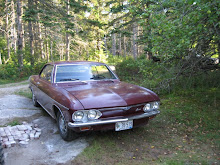It's rarely been an issue with my '66 Land Rover but cooling systems issues continue to plague me with the '80 Spitfire.On the last 110 mile trip home from leading a library program in Ocean Park, ME, the temperature gauge pegged itself within 45 miles of highway driving. It's been a challenge to diagnose the reason[s].
The tools to aid in the diagnosis include an infrared thermometer, a compression tester and an exhaust gasses analyzer.
I carried the infrared thermometer with me during the last trip. As the temperature gauge rose to "H" I had to wait until I got off the highway in Brunswick before I could check it out and fill up the gas tank. The temperature readings at the top and bottom of the radiator were about 190 degrees at the top and 160 degrees at the bottom - so the radiator had reduced the coolant temperature effectively. The thermostat housing temperature was about 210 degrees; it should be hot there as the water exits the block at that point. I did notice some boiling over at the overflow bottle, but then, it was completely full, so the bottle's contents had no place to go except out the vent hole. Still, the "H" marking on the gauge would be uncomfortable to watch for the rest of the trip.
The following weekend it was time for the compression test. I found I had 130-133-130-130 on cylinders 1-4. Since the numbers were so close it did not appear that I had a head gasket problem. And this past weekend, I ran the exhaust gas analyzer test. That test uses a fluid that turns color in the presence of CO2 or similar exhaust gasses in the coolant - which would occur if you have a head gasket leak. I also removed the coolant temperature sensor from the head; it had a thin covering of sludge on it so I cleaned it off and reinstalled it. The sensor does seem to work as the gauge moves up and down as the engine warms up.
So if the problems are unlikely to be head gasket-related, I will turn my attention again to the radiator and coolant. I want to drain the coolant one more time to check its color and to force more water through the system to see if I can force more sludge and silt out of the system. Tim Hutchisen of Penn Ridge Motors recommended this as it's possible the issue is in the amount of flow through the radiator.












No comments:
Post a Comment